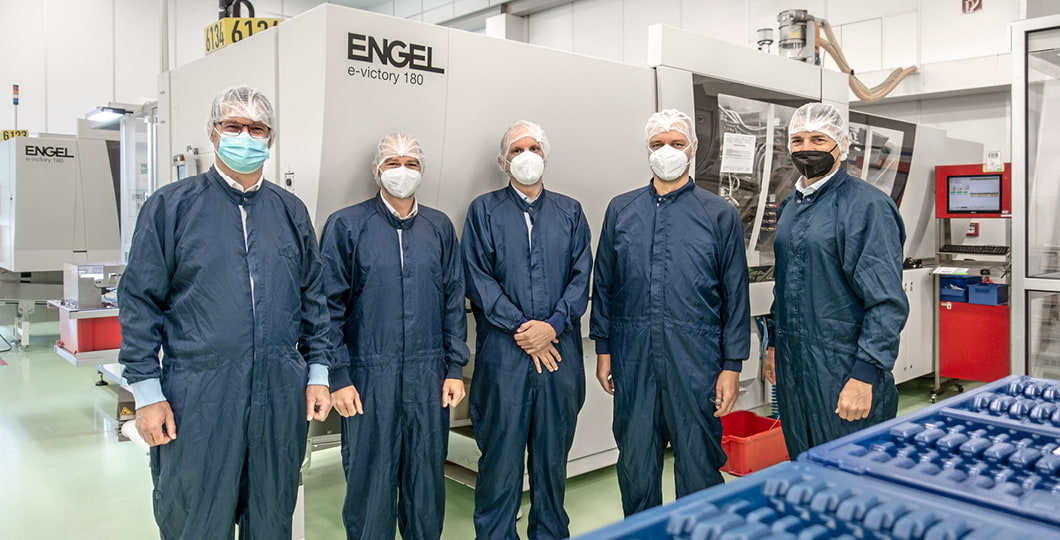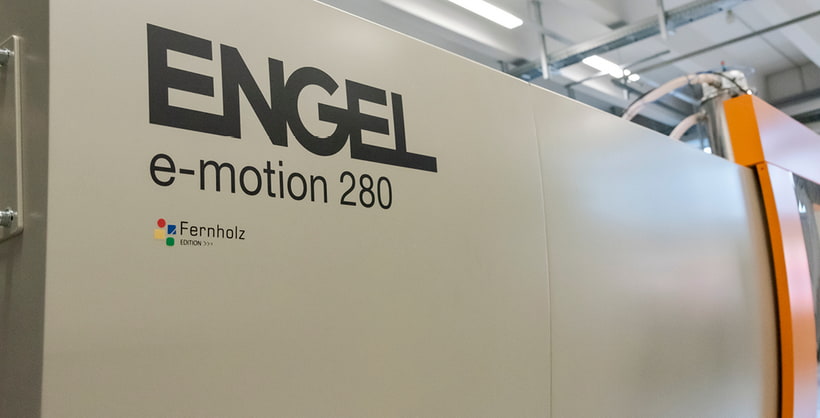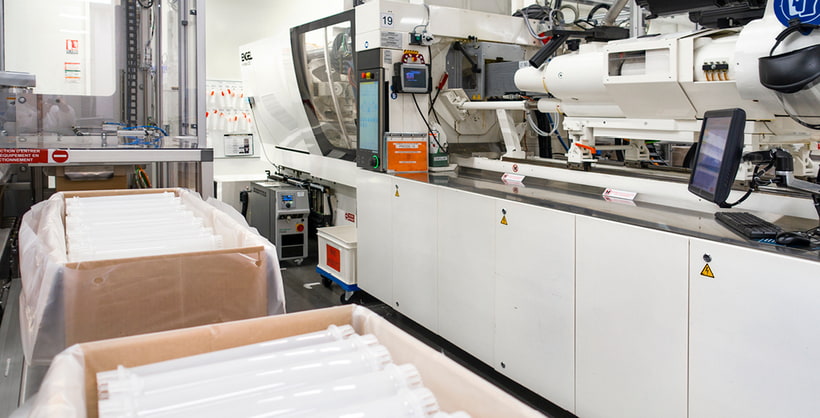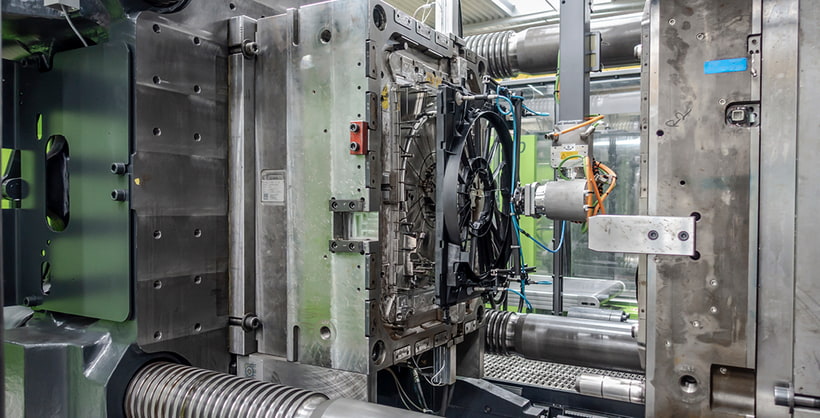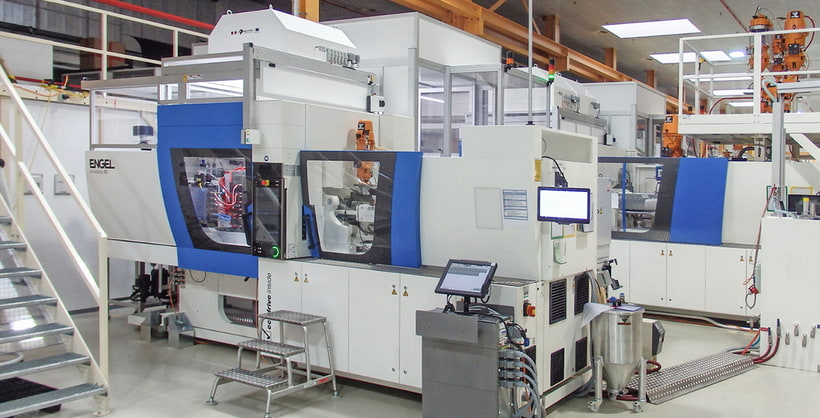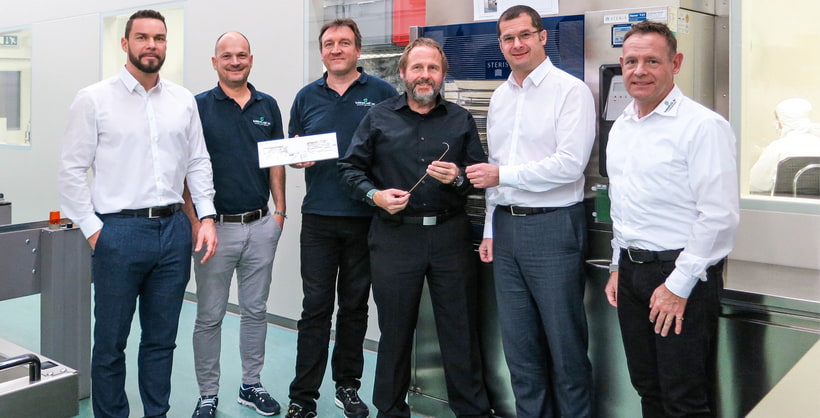Tie-bar-less machines for multi-cavity moulds
The requirement:
A newly developed inhaler generation with exchangeable active ingredient cartridges required a new design of the drive tubes. These consist of various assembly and functional elements; polybutylene terephthalate (PBT) is used as the material. In order to increase productivity per unit area, Gerresheimer uses high-cavity moulds in production. The specifications for the production of these demanding plastic precision parts in the clean room were defined as follows:
- Optimum use of the production area in the clean room
- Consistently high melt quality of the difficult-to-process material PBT
- Consistently high and uniform part quality in all mould cavities
- Gentle handling of the cost-intensive tools
The machine:
Based on the mould design and the specifications, Gerresheimer became aware of the tie-bar-less, hybrid injection moulding machine e-victory. Since the machine has no tie bars to limit the mould space, comparatively large moulds can be mounted on smaller machines with low clamping force in this series. The area of the mould fixing platens can be fully utilised right to the edge. This is directly reflected in the productivity per unit area and is a tangible advantage, especially in the expensive cleanroom.
"When using a tie-bar machine, we would need a higher clamping force class for our multi-cavity moulds. Tie-bar-less technology helps us select smaller machines with lower energy consumption."
Helmut Neuper, Expert Injection Moulding Technology at Gerresheimer
The test:
However, as Gerresheimer had not previously used tie-bar-less injection moulding machines, there were some reservations about this technology: "What about platen parallelism when opening and closing the mould? Can you produce precision plastic parts without tie bars? Does tie-bar-less technology lead to faster wear of the mould? - These were the questions that occupied our technical experts," says Neuper.
Gerresheimer put an e-victory machine through its paces for a whole year. For this purpose, an XD laser measuring device was attached to the top of the mould and the distance to the moving platen was recorded in each case. And this was done several times over the entire injection moulding cycle with different mould opening states and different mould temperatures.
Subsequently, a tie-bar-less injection moulding machine was tested in production operation with a multi-cavity mould over a period of two and a half years. After a further, final dynamic platen parallelism test, Gerresheimer was completely convinced by the results:
"We have been able to prove with the sound tests that the guiding accuracy on tie-bar-less machines is at least as good as on tie-bar machines."
Peter Felber, Global Senior Director Operational Excellence at Gerresheimer
Implementation:
Based on the promising results of the test series, Gerresheimer opted for the tie-bar-less e-victory. ENGEL covered the requirements defined at the beginning as follows:
- Optimum use of the production area in the clean room
The large, tie-bar-less mould area of the e-victory enables the use of compact machines with the exact clamping force required instead of oversized tie-bar machines. - Consistently high melt quality of the difficult-to-process material polybutylene terephthalate.
The precise, electric injection unit of the e-victory was equipped with plasticising components specially adapted to the requirements of PBT. High melt quality and reproducibility are thus ensured. - Consistently high and uniform part quality in all cavities.
The patented Force Divider of the tie-bar-less clamping unit ensures absolutely homogeneous clamping force distribution over the entire platen surface. Combined with the high platen parallelism, optimum part quality is achieved, especially with multi-cavity moulds. - Gentle handling of the cost-intensive moulds
Extensive tests of the e-victory injection moulding machine by Gerresheimer show that the high guidance accuracy and platen parallelism of the tie-bar-less clamping unit prevent mould wear. These properties remain constant even with very heavy moulds and over several years.
Today, Gerresheimer operates more than 30 tie-bar-less injection moulding machines from ENGEL. These are used for the production of precision plastic medical parts on multi-cavity moulds.
We are always pleased when our customers put our tie-bar-less injection moulding machines through their paces. At Gerresheimer, the expectations in terms of platen parallelism, clamping force distribution, precision and mould protection were more than met. And the results of these test series prove to me once again that the great success of the tie-bar-less ENGEL is absolutely no coincidence.

Has the use of tie-bar-less injection moulding machines proved successful for multi-cavity moulds?
Yes, the choice of the tie-bar-less e-victory from ENGEL has paid off for Gerresheimer in more ways than one:
- the high platen parallelism and homogeneous clamping force distribution ensure uniformly high quality of the injection moulded parts in all cavities
- the precise electric injection unit ensures high repeatability shot after shot
- optimum melt quality is achieved thanks to customised plasticising components
- the high guiding accuracy of the tie-bar-less clamping unit protects the expensive moulds
- the use of compact machines saves expensive production space in the clean room and increases productivity per unit area
Do you have similar challenges or would like to learn more about the project?
Our experts will be happy to advise you!
More about our products from the article
Tie-bar-less, hydraulic injection moulding machine victory
The first choice for multi-cavity moulds thanks to optimum clamping force distribution and maximum space in the mould cavity
Tie-bar-less, hybrid injection moulding machine e-victory
High precision on the tie-bar-less clamping side as well as on the servo-electrically driven injection side
ENGEL Medical Technology
Our solutions for injection moulding of medical plastic parts in the clean room and clean room

